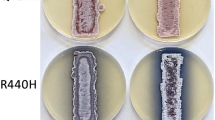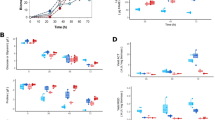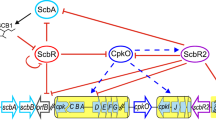Abstract
Lincomycin forms cross-links within the peptidyl transferase loop region of the 23S ribosomal RNA (rRNA) of the 50S subunit of the bacterial ribosome, which is the site of peptide bond formation, thereby inhibiting protein synthesis. We have previously reported that lincomycin at concentrations below the minimum inhibitory concentration potentiates the production of secondary metabolites in actinomycete strains, suggesting that activation of these strains by utilizing the dose-dependent response of lincomycin could be used to effectively induce the production of cryptic secondary metabolites. Here, we aimed to elucidate the fundamental mechanisms underlying lincomycin induction of secondary metabolism in actinomycetes. In the present study, the dose-dependent response of lincomycin on gene expression of the model actinomycete Streptomyces coelicolor A3(2) and possible relationships to secondary metabolism were investigated. RNA sequencing analysis indicated that lincomycin produced enormous changes in gene expression profiles. Moreover, reverse transcription PCR and/or comparative proteome analysis revealed that in S. coelicolor A3(2), lincomycin, which was used at concentrations for markedly increased blue-pigmented antibiotic actinorhodin production, rapidly enhanced expression of the gene encoding the lincomycin-efflux ABC transporter, the 23S rRNA methyltransferase, and the ribosome-splitting factor to boost the intrinsic lincomycin resistance mechanisms and to reconstruct the probably stalled 70S ribosomes with lincomycin; and in contrast temporarily but dramatically reduced mRNA levels of housekeeping genes, such as those encoding FoF1 ATP synthase, RNA polymerase, ribosomal proteins, and transcription and translation factors, with an increase in intracellular NTPs. A possible mechanism for lincomycin induction of secondary metabolism in S. coelicolor A3(2) is discussed on the basis of these results.






Similar content being viewed by others
References
Amano S, Morota T, Kano YK, Narita H, Hashidzume T, Yamamoto S, Mizutani K, Sakuda S, Furihata K, Takano-Shiratori H, Takano H, Beppu T, Ueda K (2010) Promomycin, a polyether promoting antibiotic production in Streptomyces spp. J Antibiot 63:486–491. https://doi.org/10.1038/ja.2010.68
Amano S, Sakurai T, Keisuke E, Takano H, Beppu T, Furihata K, Sakuda S, Ueda K (2011) A cryptic antibiotic triggered by monensin. J Antibiot 64:703. https://doi.org/10.1038/ja.2011.69
Bentley SD, Chater KF, Cerdeno-Tarraga AM, Challis GL, Thomson NR, James KD, Harris DE, Quail MA, H. Kieser, Harper D, Bateman A, Brown S, Chandra G, Chen CW, Collins M, Cronin A, Fraser A, Goble A, Hidalgo J, Hornsby T, Howarth S, Huang CH, Kieser T, Larke L, Murphy L, Oliver K, O’Neil S, Rabbinowitsch E, Rajandream MA, Rutherford K, Rutter S, Seeger K, Saunders D, Sharp S, Squares R, Squares S, Taylor K, Warren T, Wietzorrek A, Woodward J, Barrell BG, Parkhill J, Hopwood DA (2002) Complete genome sequence of the model actinomycete Streptomyces coelicolor A3(2). Nature 417:141–147. https://doi.org/10.1038/417141a
Bibb MJ (2005) Regulation of secondary metabolism in streptomycetes. Curr Opin Microbiol 8:208–215. https://doi.org/10.1016/j.mib.2005.02.016
Calabrese EJ, Baldwin LA (2003) Hormesis: the dose-response revolution. Ann Rev Pharmacol Toxicol 43:175–197. https://doi.org/10.1146/annurev.pharmtox.43.100901.140223
Coatham ML, Brandon HE, Fischer JJ, Schümmer T, Wieden HJ (2016) The conserved GTPase HflX is a ribosome splitting factor that binds to the E-site of the bacterial ribosome. Nucleic Acids Res 44:1952–1961. https://doi.org/10.1093/nar/gkv1524
Davies J, Spiegelman GB, Yim G (2006) The world of subinhibitory antibiotic concentrations. Curr Opin Microbiol 9:445–453. https://doi.org/10.1016/j.mib.2006.08.006
Douthwaite S (1992) Interaction of the antibiotics clindamycin and lincomycin with Escherichia coli 23S ribosomal RNA. Nucleic Acids Res 20:4717–4720. https://doi.org/10.1093/nar/20.18.4717
Herbert S, Barry P, Novick PR (2001) Suninhibitory clindamysin differentially inhibits transcription of exoprotein genes in Staphylococcus aureus. Infect Immune 69:2996–3003. https://doi.org/10.1128/IAI.69.5.2996-3003.2001
Hong W, Zeng J, Xie J (2014) Antibiotic drugs targeting bacterial RNAs. Acta Pharm Sin B 4:258–265. https://doi.org/10.1016/j.apsb.2014.06.012
Hosaka T, Xu J, Ochi K (2006) Increased expression of ribosome recycling factor is responsible for the enhanced protein synthesis during the late growth phase in an antibiotic-overproducing Streptomyces coelicolor ribosomal rpsL mutant. Mol Microbiol 61:883–897. https://doi.org/10.1111/j.1365-2958.2006.05285.x
Hosaka T, Ohnishi-Kameyama M, Muramatsu H, Murakami K, Tsurumi Y, Kodani S, Yoshida M, Fujie A, Ochi K (2009) Antibacterial discovery in actinomycetes strains with mutations in RNA polymerase or ribosomal protein S12. Nat Biotechnol 27:462–464. https://doi.org/10.1038/nbt.1538
Huang J, Lih CJ, Pan KH, Cohen SN (2001) Global analysis of growth phase responsive gene expression and regulation of antibiotic biosynthetic pathways in Streptomyces coelicolor using DNA microarrays. Genes Dev 15:3183–3192. https://doi.org/10.1101/gad.943401
Imai Y, Fujiwara T, Ochi K, Hosaka T (2012) Development of the ability to produce secondary metabolites in Streptomyces through the acquisition of erythromycin resistance. J Antibiot (Tokyo) 65:323–326. https://doi.org/10.1038/ja.2012.16
Imai Y, Sato S, Tanaka Y, Ochi K, Hosaka T (2015) Lincomycin at subinhibitory concentrations potentiates secondary metabolite production by Streptomyces spp. Appl Environ Microbiol 81:3869–3879. https://doi.org/10.1128/AEM.04214-14
Jenkins G, Cundliffe E (1991) Cloning and characterization of two genes from Streptomyces lividans that confer inducible resistance to lincomycin and macrolide antibiotics. Gene 108:55–62. https://doi.org/10.1016/0378-1119(91)90487-V
Kallifidas D, Thomas D, Doughty P, Paget MS (2010) The σR regulon of Streptomyces coelicolor A3(2) reveals a key role in protein quality control during disulphide stress. Microbiology 156:1661–1672. https://doi.org/10.1099/mic.0.037804-0
Kieser T, Bibb MJ, Buttner MJ, Chater KF, Hopwood DA (2000) Practical Streptomyces Genetics. The John Innes Foundation, Norwich
Lin JT, Connelly MB, Amolo C, Otani S, Yaver DS (2005) Global transcriptional response of Bacillus subtilis to treatment with subinhibitory concentrations of antibiotics that inhibit protein synthesis. Antimicrob Agents Chemother 49:1915–1926. https://doi.org/10.1128/AAC.49.5.1915-1926.2005
Meng S, Wu H, Wang L, Zhang B, Bai L (2017) Enhancement of antibiotic productions by engineered nitrate utilization in actinomycetes. Appl Microbiol Biotechnol 101:5341–5352. https://doi.org/10.1007/s00253-017-8292-7
Nishimura K, Hosaka T, Tokuyama S, Okamoto S, Ochi K (2007) Mutations in rsmG, encoding a 16S rRNA methyltransferase, result in low-level streptomycin resistance and antibiotic overproduction in Streptomyces coelicolor A3(2). J Bacteriol 189:3876–3883. https://doi.org/10.1128/JB.01776-06
Ochi K (1987) Metabolic initiation of differentiation and secondary metabolism by Streptomyces griseus: significance of the stringent response (ppGpp) and GTP content in relation to A factor. J Bacteriol 169:3608–3616. https://doi.org/10.1128/jb.169.8.3608-3616.1987
Romero D, Traxler MF, Lopez D, Kolter R (2011) Antibiotics as signal molecules. Chem Rev 111:5492–5505. https://doi.org/10.1021/cr2000509
Sabina J, Dover N, Templeton LJ, Smulski DR, Soll D, LaRossa RA (2003) Interfering with different steps of protein synthesis explored by transcriptional profiling of Escherichia coli K-12. J Bacteriol 185:6158–6170. https://doi.org/10.1128/JB.185.20.6158-6170.2003
Shibl MA (1993) Effect of antibiotics on production of enzymes and toxins by microorganisms. Rev Infect Dis 5:865–875. https://doi.org/10.1093/clinids/5.5.865
Shima J, Hesketh A, Okamoto S, Kawamoto S, Ochi K (1996) Induction of actinorhodin production by rpsL (encoding ribosomal protein S12) mutations that confer streptomycin resistance in Streptomyces lividans and Streptomyces coelicolor A3(2). J Bacteriol 178:7276–7284. https://doi.org/10.1128/jb.178.24.7276-7284.1996
Tanaka Y, Izawa M, Hiraga Y, Misaki Y, Watanabe T, Ochi K (2017) Metabolic perturbation to enhance polyketide and nonribosomal peptide antibiotic production using triclosan and ribosome-targeting drugs. Appl Microbiol Biotechnol 101:4417–4431. https://doi.org/10.1007/s00253-017-8216-6
Wang G, Hosaka T, Ochi K (2008) Dramatic activation of antibiotic production in Streptomyces coelicolor by cumulative drug resistance mutations. Appl Environ Microbiol 74:2834–2840. https://doi.org/10.1128/AEM.02800-07
Weisblum B (1995) Erythromycin resistance by ribosome modification. Antimicrob Agents Chemother 39:577–585. https://doi.org/10.1128/AAC.39.3.577
Yim G, Wang HH, Davies J (2006) The truth about antibiotics. Int J Med Microbiol 296:163–170. https://doi.org/10.1016/j.ijmm.2006.01.039
Zhang HZ, Schmidt H, Piepersberg W (1992) Molecular cloning and characterization of two lincomycin-resistance genes, lmrA and lmrB, from Streptomyces lincolnensis 78-11. Mol Microbiol 6:2147–2157. https://doi.org/10.1111/j.1365-2958.1992.tb01388.x
Acknowledgements
This work was financially supported by a Grant-in-Aid for Young Scientists (A) to Takeshi Hosaka from the Japan Society for the Promotion of Science (Grant No. 25712008).
Author information
Authors and Affiliations
Corresponding author
Ethics declarations
Conflict of interest
The authors declare that they have no conflict interest.
Electronic supplementary material
Below is the link to the electronic supplementary material.
Rights and permissions
About this article
Cite this article
Ishizuka, M., Imai, Y., Mukai, K. et al. A possible mechanism for lincomycin induction of secondary metabolism in Streptomyces coelicolor A3(2). Antonie van Leeuwenhoek 111, 705–716 (2018). https://doi.org/10.1007/s10482-018-1021-0
Received:
Accepted:
Published:
Issue Date:
DOI: https://doi.org/10.1007/s10482-018-1021-0




